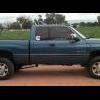- Replies 1.3k
- Views 166.8k
- Created
- Last Reply
Top Posters In This Topic
-
 Me78569 472 posts
Me78569 472 posts -
 Mopar1973Man 178 posts
Mopar1973Man 178 posts -
 TFaoro 121 posts
TFaoro 121 posts -
 Carbur8tr 92 posts
Carbur8tr 92 posts
Most Popular Posts
-
Good news!Timing at cruise for late model trucks with electric Cruise control now works! glad that one is fixedOffidle boost is working now for late and early trucks, varified by multiple trucks at mu
-
I think that code is a result of the ecm asking for xxx fuel, then not getting a response back from the vp44 saying " I fueled xxx" I would clean your connection to the vp44 and the ecm,
-
Did some more testing this weekend. The Passenger in the trailer thought things went well also. Smooth smoke free ride. It was a good weekend. However in all s


Let me start off by saying that I am in no way affiliated with Quadzilla or Diesel Auto Power. I was simply asked to test the new updates because I have big injectors, I'm familiar with the Quad, and I know the person doing all of the tuning. This person wishes to remain anonymous, so it will stay that way.
On to the good stuff!!!
So what is V2? Basically it's a way to gain more control over the tuning parameters, with an emphasis on CLEAN POWER. I've got big injectors, and I've driven my own truck enough that I can drive it virtually smoke free, but I have to be very careful with the right petal (even when set to stock)
Here are the custom tuning parameters:
Alright, let's start with the power levels:
0=stock
1=Power Percent (Explained later)
2=Fuel mileage (Same as the old number 1)
3=can-bus only (Same as old number 2)
4=can-bus + wiretap (same as old number 3)
and so on to the maximum level set is reached.
So, as you can see the first 8 parameters (through "TPS CAN Minimum") are the same as they've always been. They will function just like they used to.
The next two have to do with wiretap fueling. The "Boost Pump Scaling" gives the %specified of called for wiretap fueling if the boost is below the "boost pump low limit"
As an example:(Let's say it's set on level 10) In the pictures you can see I have the scaling set to 0% until 15psi. This means I'll get zero wiretap fueling until I hit 15psi of boost. If it was set at 50% I would get 600us of wiretap before 15psi.
This greatly reduces the amount of smoke output without reducing your peak power.
Next we have Power Percent. This is the "new" level one! Here we have the percentage of stock power called for at all times. This is perfect to use for emissions testing, letting the wife/kids drive etc. This is also another way to reduce smoke if you're wanting to be really clean.
Next is boost scaling. This is the same as it used to be. Just a smoothing feature.
Next we have PSI% listed 0-17 in increments of 1. This feature allows you to set the amount of stock power based on boost. It allows you to ramp up the power from 0-17psi, effectively reducing smoke and making the truck more driveable.
Now for my experience with testing.
Level 1: With my truck stock, I can floor it at any time and create quite a cloud of smoke. You'd swear I have a tuner cranked, but it's not. With my truck set to 70%, I can floor it while doing 55mph in 6th and get as big of a puff as a stock 24V. Meanwhile it'll pull about 34psi @ 2000rpm and 40psi by 2500rpm. It does make the truck a little doggy, but I could adjust the percentage up as I saw fit and still keep smoke to a minimum. This would be perfect if someone were to borrow my truck (never going to happen but you get the point) They could try to hotrod it as much as they want but won't be able to. I do think this would make emissions a breeze to pass, and it could be used as a safety device to keep the truck from being stolen. Essentially you can set it to 1% and the truck would only idle.
Now for the PSI%: With the power level turned up around 1500rpm I can stab the throttle (0psi of boost) and get nothing more than a slight haze until the boost picks up and the quad starts fueling hard. Spool is still excellent under these conditions, I just need to work on my top-end fuel command to reduce the smoke up there. This has made the biggest difference in CLEAN power. The quad is essentially rolling into the throttle for you as the boost comes up so you don't cloud the highway when you get on it.
Now the "Boost pump scaling" and "boost pump low limit": The wiretap fueling is essentially it's "own" programmer. It doesn't follow the rules of the can-bus fueling. This was taking effect in my description above because it doesn't wiretap fuel for me until 15psi of boost. Thus why it's only a haze until 15psi.
Now, what I'm not quite happy with yet. Off idle, if I stab the throttle on level 1 I get a puff of smoke. I am told this is because of where the quad takes over and starts controlling things. It's being worked on and should be fixed soon. Other than that I'm very happy! I do have only 20 miles or so of testing, but this does look very promising. I'll be putting 50 miles on in the morning and 50 miles in the afternoon, so I'll have more info then.
Any questions post em up and I'll do my best to answer them. The future of clean power for 24V's looks promising
Edited by Me78569
Changed the title for SEO reasons